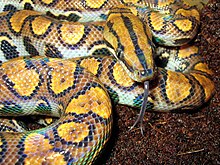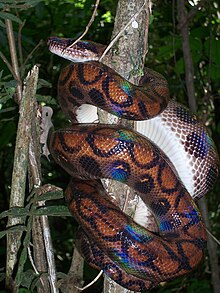Epicrates (snake): Difference between revisions
Appearance
Content deleted Content added
| Line 49: | Line 49: | ||
|([[Edward Drinker Cope|Cope]], 1862) |
|([[Edward Drinker Cope|Cope]], 1862) |
||
|align="center"| |
|align="center"| |
||
|Paraguayan rainbow boa |
|||
| |
|||
|Paraguay, Bolivia, Argentina, and Brazil |
|Paraguay, Bolivia, Argentina, and Brazil |
||
|- |
|- |
||
| Line 55: | Line 55: | ||
|[[John Edward Gray|Gray]], 1849 |
|[[John Edward Gray|Gray]], 1849 |
||
|align="center"| |
|align="center"| |
||
| |
|Colombian rainbow boa |
||
|[[Nicaragua]], [[Costa Rica]], [[Panama]], Colombia, Venezuela, Guyana, Suriname, northern Brazil, [[Trinidad]], [[Tobago]], [[Isla Margarita]]. |
|[[Nicaragua]], [[Costa Rica]], [[Panama]], Colombia, Venezuela, Guyana, Suriname, northern Brazil, [[Trinidad]], [[Tobago]], [[Isla Margarita]]. |
||
|- |
|- |
||
Revision as of 09:05, 15 January 2022
| Epicrates | |
|---|---|

| |
| Brazilian rainbow boa, E. c. cenchria | |
| Scientific classification | |
| Domain: | Eukaryota |
| Kingdom: | Animalia |
| Phylum: | Chordata |
| Class: | Reptilia |
| Order: | Squamata |
| Suborder: | Serpentes |
| Family: | Boidae |
| Subfamily: | Boinae |
| Genus: | Epicrates Wagler, 1830 |
| Synonyms | |
| |
Epicrates is a genus of non-venomous snakes in the subfamily Boinae of the family Boidae. The genus is native to South America and Central America. Five species are currently recognized as being valid, including the rainbow boa.[2]
Distribution and habitat
Species of Epicrates are found in lower Central America through South America as far south as Argentina.[1]
Species
| Species[2] | Taxon author[2] | Subsp.*[2] | Common name | Geographic range[1] |
|---|---|---|---|---|
| E. alvarezi | Ábalos, Báez & Nader, 1964 | Argentinian rainbow boa | northern Argentina, southeastern Bolivia, western Paraguay | |
| E. assisi | Machado, 1945 | Caatinga rainbow boa | Brazil | |
E. cenchriaT |
(Linnaeus, 1758) | rainbow boa[2] | French Guiana, Suriname, Guyana, Colombia, Venezuela, Peru, Brazil, Bolivia, and Argentina | |
| E. crassus | (Cope, 1862) | Paraguayan rainbow boa | Paraguay, Bolivia, Argentina, and Brazil | |
E. maurusT |
Gray, 1849 | Colombian rainbow boa | Nicaragua, Costa Rica, Panama, Colombia, Venezuela, Guyana, Suriname, northern Brazil, Trinidad, Tobago, Isla Margarita. |
*) Not including the nominate subspecies.
T) Type species.[1]
Etymology
The specific name, alvarezi, is in honor of Argentine herpetologist Antenor Álvarez (1864–1948).[3]
The specific name, assisi, is in honor of Arlindo de Assis who collected the holotype.[4]
References
- ^ a b c d McDiarmid RW, Campbell JA, Touré T (1999). Snake Species of the World: A Taxonomic and Geographic Reference, vol. 1. Washington, District of Columbia: Herpetologists' League. 511 pp. ISBN 1-893777-00-6 (series). ISBN 1-893777-01-4 (volume).
- ^ a b c d e "Epicrates". Integrated Taxonomic Information System. Retrieved 6 July 2008.
- ^ Beolens B, Watkins M, Grayson M (2011). The Eponym Dictionary of Reptiles. Baltimore: Johns Hopkins University Press. xiii + 296 pp. ISBN 978-1-4214-0135-5. (Epicrates alvarezi, p. 6).
- ^ Species Epicrates assisi at The Reptile Database www.reptile-database.org.
External links
Wikimedia Commons has media related to Epicrates.
- Epicrates at the Reptarium.cz Reptile Database. Accessed 6 July 2008.
